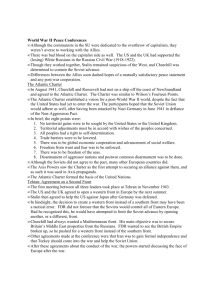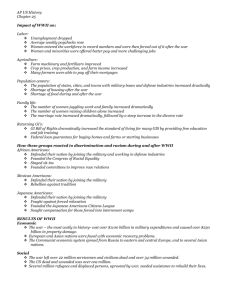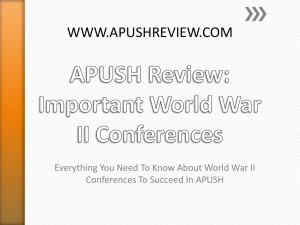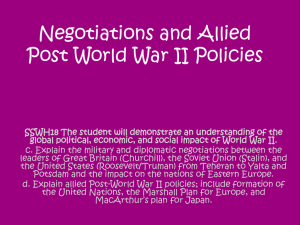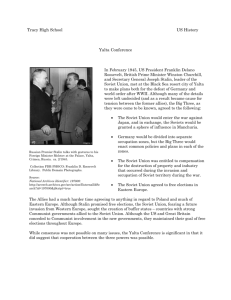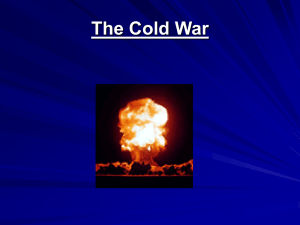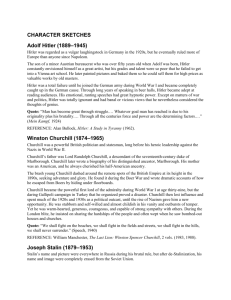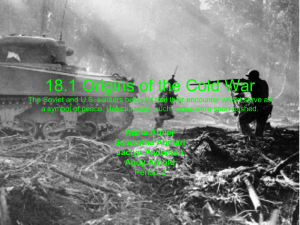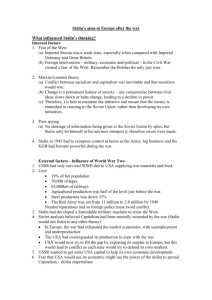World War II Peace Conferences
advertisement
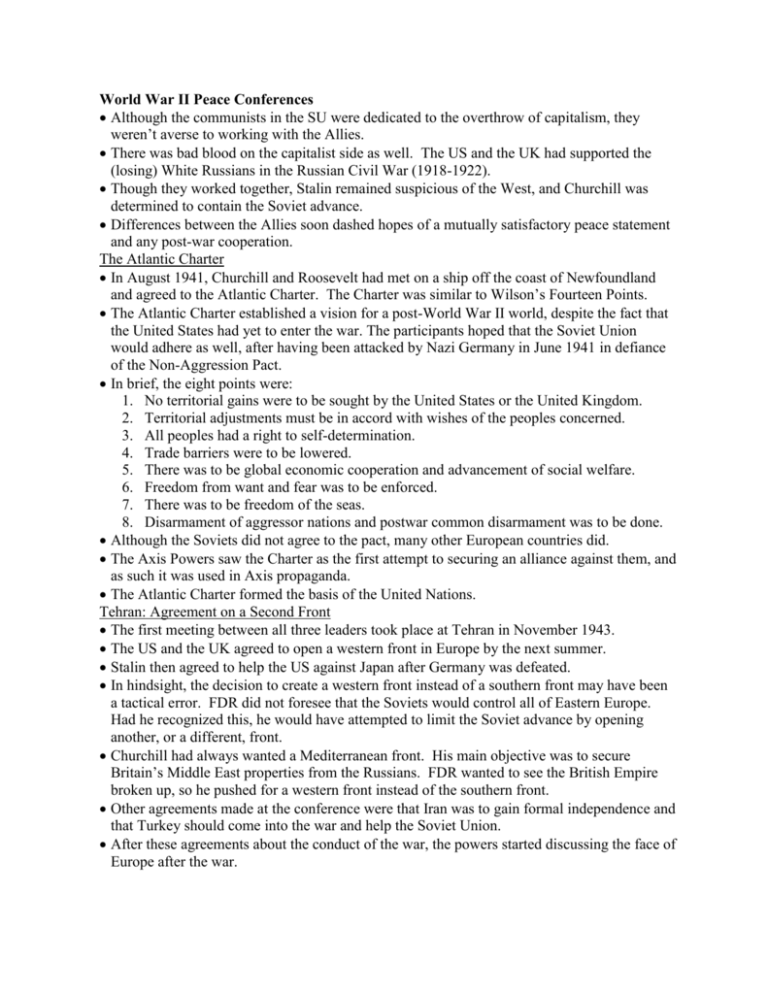
World War II Peace Conferences Although the communists in the SU were dedicated to the overthrow of capitalism, they weren’t averse to working with the Allies. There was bad blood on the capitalist side as well. The US and the UK had supported the (losing) White Russians in the Russian Civil War (1918-1922). Though they worked together, Stalin remained suspicious of the West, and Churchill was determined to contain the Soviet advance. Differences between the Allies soon dashed hopes of a mutually satisfactory peace statement and any post-war cooperation. The Atlantic Charter In August 1941, Churchill and Roosevelt had met on a ship off the coast of Newfoundland and agreed to the Atlantic Charter. The Charter was similar to Wilson’s Fourteen Points. The Atlantic Charter established a vision for a post-World War II world, despite the fact that the United States had yet to enter the war. The participants hoped that the Soviet Union would adhere as well, after having been attacked by Nazi Germany in June 1941 in defiance of the Non-Aggression Pact. In brief, the eight points were: 1. No territorial gains were to be sought by the United States or the United Kingdom. 2. Territorial adjustments must be in accord with wishes of the peoples concerned. 3. All peoples had a right to self-determination. 4. Trade barriers were to be lowered. 5. There was to be global economic cooperation and advancement of social welfare. 6. Freedom from want and fear was to be enforced. 7. There was to be freedom of the seas. 8. Disarmament of aggressor nations and postwar common disarmament was to be done. Although the Soviets did not agree to the pact, many other European countries did. The Axis Powers saw the Charter as the first attempt to securing an alliance against them, and as such it was used in Axis propaganda. The Atlantic Charter formed the basis of the United Nations. Tehran: Agreement on a Second Front The first meeting between all three leaders took place at Tehran in November 1943. The US and the UK agreed to open a western front in Europe by the next summer. Stalin then agreed to help the US against Japan after Germany was defeated. In hindsight, the decision to create a western front instead of a southern front may have been a tactical error. FDR did not foresee that the Soviets would control all of Eastern Europe. Had he recognized this, he would have attempted to limit the Soviet advance by opening another, or a different, front. Churchill had always wanted a Mediterranean front. His main objective was to secure Britain’s Middle East properties from the Russians. FDR wanted to see the British Empire broken up, so he pushed for a western front instead of the southern front. Other agreements made at the conference were that Iran was to gain formal independence and that Turkey should come into the war and help the Soviet Union. After these agreements about the conduct of the war, the powers started discussing the face of Europe after the war. Stalin was determined to keep some of the land promised him in the Non-Aggression Pact. The powers agreed to shift the country of Poland westward, and to allow Russia to keep much of the rest. This arrangement was made formal at the Potsdam Conference. The Soviet Union also agreed to discuss a successor organization to the League of Nations. The Moscow Conferences In the First Moscow Conference of 1941, the US and the UK agreed to help the Soviet Union against the Nazis. In the Second Moscow Conference of 1942, the US and the UK agreed to open a North Africa campaign. The Soviets had started pressing the Allies to open a western front. In the Third Moscow Conference of 1943 resulted in the Moscow Declaration and created the European Advisory Commission. The Declaration said that the three nations would pursue wars until the Axis accepted unconditional surrender. The EAC studied solutions to the postwar political problems in Europe. After submitting its recommendations in Potsdam, it was disbanded. The Fourth Moscow Conference was held in October of 1944, between Churchill and Stalin. By this time, the Soviets had pushed into much of eastern Europe, and the US and UK had a foothold in the West. The race to Berlin was on. Churchill and Stalin agreed to split eastern Europe and the Balkans into spheres of influence. These spheres roughly held until 1990. Dumbarton Oaks The Dumbarton Oaks Conference was held in Washington in August, 1944. Ministers from the US, UK, the Soviet Union, and China met to discuss formation of a new group of countries called the United Nations. The UN would be given a far more sweeping mandate than the League of Nations. It would have a way to ensure peace: the Security Council. The Soviets insisted that there be a way to stop legislation that they opposed. From this arose the convoluted veto structure of the Security Council. The UN Charter was fully written later in 1945 by a number of people representing different countries and organizations. The term “United Nations” was the official name of the Allied Powers. It was first used by FDR and Churchill after issuing the Atlantic Charter. It was adopted as the name of the new institution in 1945. Yalta Conference The Big Three met in Yalta on the Crimean Sea in February, 1945. The US and UK were still in France, but the Soviets were advancing on Berlin. To encourage Russian participation in the war against Japan, Roosevelt and Churchill made extensive concessions to Russia, ceding the Soviets some islands which had long belonged to Japan. Those islands are still in contention today. The Three also agreed to split Germany and Austria (and Berlin and Vienna) into four zones each, one for the Americans, British, French, and Soviets. Note that all three leaders had their own agendas. FDR wanted Russian help with Japan and wanted to pursue self-determination. Stalin wanted to set up Soviet spheres of influence in Eastern Europe. He also wanted reparations. Churchill wanted to keep the British Empire intact and prevent Soviet expansion. Stalin agreed to hold free elections in Poland. When they were held in 1947, though, they were rigged to support the communists. After the communists took over, there were no more elections in Poland. Churchill and FDR agreed to remove millions of Germans who would be living in the new Polish borders. This is the first manifestation of the “there-are-too-many-ethnic-groupsspread-around-Europe-we-have-to-move-them-into-their-own-countries” mentality that prevailed after WWII. Potsdam Conference The Big Three met for the last time in the Berlin suburb of Potsdam in July 1945. Germany had been defeated months earlier, and America had developed (though not used) the atomic bomb. The attendees at the conference were Stalin from the Soviet Union and Truman from the US. The results from the British general elections of 1945 became known during the conference. The Labour Party had won a landslide victory. Churchill was recalled back to Britain halfway through the conference, and the new prime minister Clement Atlee took his seat. A council was established to draft peace treaties for Germany and other Axis powers. The Allies agreed to four principles in the occupation of Germany: demilitarization, denazification, democratization and decartelization. Agreement to try German war criminals was reached (the eventual Nuremburg trials). The conference was really more one of disagreement than of agreement. There were disagreements over final borders, disagreements over peace treaties, disagreements over German occupation, etc. These disagreements would be the first salvos of the Cold War.
